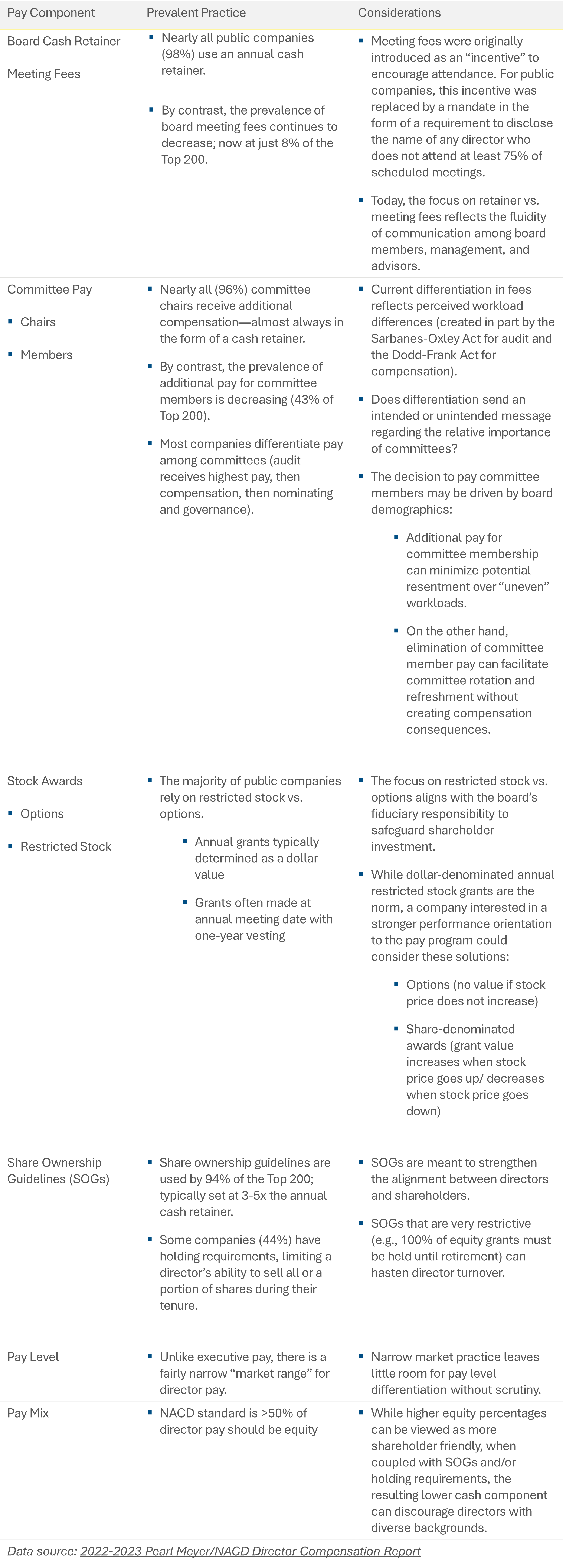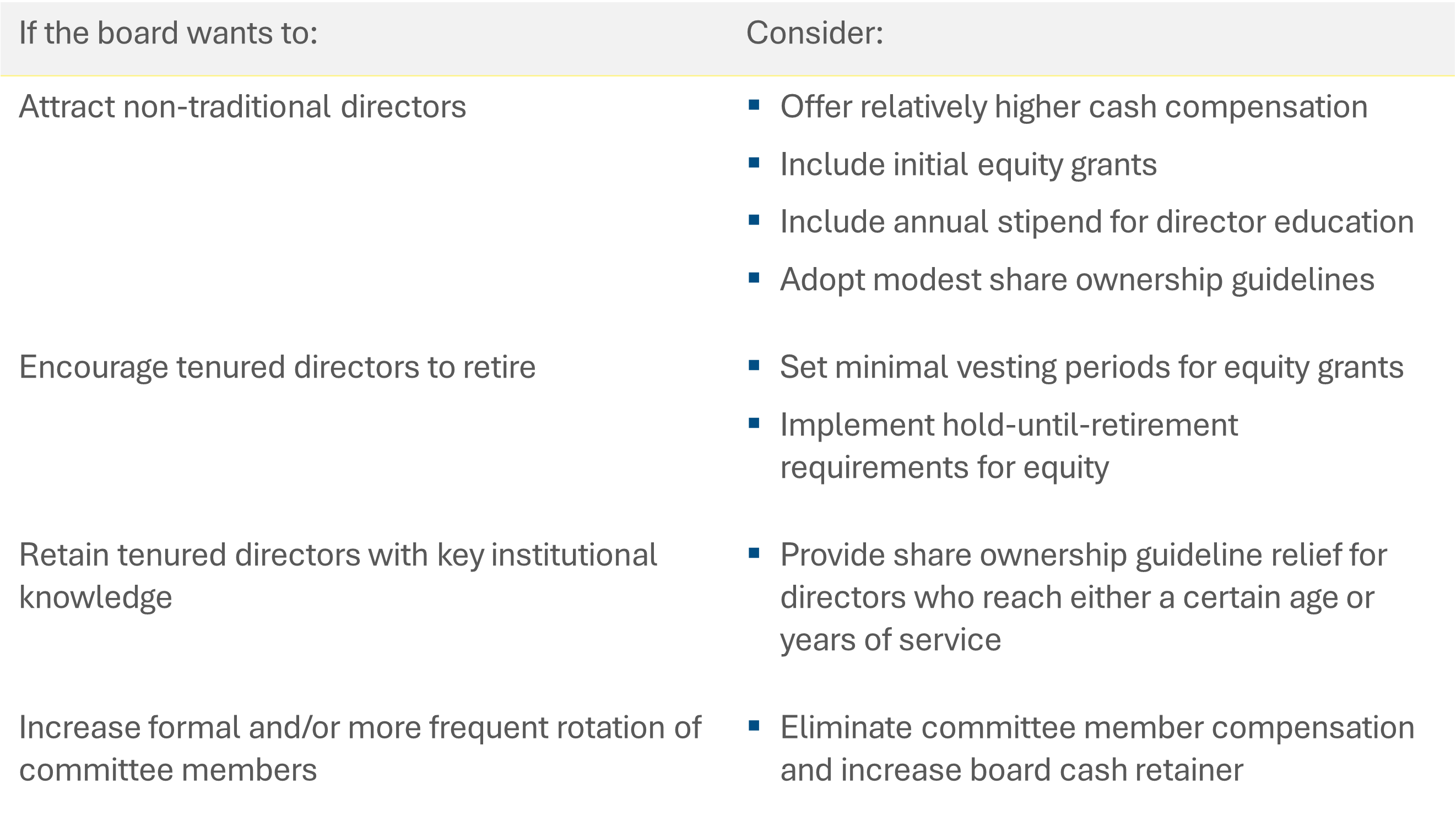
Article | Oct 2023 | NACD Blue Ribbon Commission Report
Assessing the Impact of Director Compensation on Board Culture and Agility
Elements of board effectiveness—including culture, composition, and refreshment—can be influenced by its director compensation strategy.
Editor's Note: Pearl Meyer is a strategic content partner for the National Association of Corporate Directors (NACD). Pearl Meyer is an active participant each year on the NACD Blue Ribbon Commission (BRC) and a contributor to its annual BRC reports—signature publications that propose new principles and practices to address the most critical boardroom issues. The following article was published in the director's toolkit for adopting recommendations in the 2023 BRC report Culture as the Foundation: Building a High-Performance Board.
The influence of a board’s culture on its own baseline performance, as well as its ability to adapt and keep pace with shifting organizational needs, is dependent on a robust mix of institutional knowledge, evolving experiences and skills, and fresh insights. A healthy amount of desired turnover—versus either stagnation or too many disruptive changes—supports an optimal state. Smooth transitions between incoming and outgoing directors should be the norm. All of these conditions can be supported and maintained in part through a board’s compensation strategy and policies.
Data show companies have increasingly relied on mandatory retirement policies (used today by 81% of the Top 200 companies tracked in the annual Pearl Meyer/NACD Director Compensation Report, compared to only 20% in 1995) to address board refreshment. In the context of a culture discussion, this approach is rather cold and perhaps lacking in nuance. Thoughtful boards are likely to devise a “carrot” to accompany the “stick.” Consider the very important role of board pay in the context of these questions:
- How does a board fairly treat individual directors who will be leaving as the result of a turnover exercise?
- How does a board encourage and support a culture of routine refreshment?
- How does an organization attract best-in-class nominees in an environment where there is competition for the best director candidates?
We believe the answers to these questions must be managed at both the strategy and policy levels.
The points below offer discussion starters to begin active exploration of the board’s current compensation policy and its potential impact on culture, as well as examples of changes that may encourage needed evolution.


Communicating the Board's Worth
After strategic deliberation and the crafting of a culturally aligned and supportive pay plan, communication is the next step. After all, a compensation program is only effective if it is communicated clearly and well understood by its participants, including directors.
The modern Compensation Discussion and Analysis (CD&A), a component of a proxy statement, provides a strong and clear rationale for the executive compensation program’s design and the decisions made by your compensation committee. Today’s most impactful CD&As have evolved into useful communication tools that strike the right balance between marketing an executive compensation program and satisfying critical reporting rules by the US Securities and Exchange Commission. Focusing strictly on the numbers and compliance leaves out the strategy component and could lead to misinterpretation. Think of director pay disclosure in similar terms.
Stakeholders want to be reassured that the board members who are responsible for guiding strategy are doing so in the best interests of shareholders. Communicating a thoughtful board pay approach that has been crafted in order to promote strong cultural attributes while maintaining the just-right mix of director talent has merit externally—but also among the board itself, serving as a way to reinforce the goals of the program and the desired outcomes.
A director compensation program that includes a formal communication component provides an opportunity to show that decisions have been made in a holistic framework—one that ensures board members are being paid competitively, appropriately, and responsibly based on the unique and high value they bring to the boardroom.
Creating this narrative can be succinct and straightforward. A simple rule of thumb is to follow the core guidelines used in the CD&A:
- Goals: Outline the philosophy, guiding principles, and objectives that drive the program design
- Design: Provide an overview of the pay mix structure; explain why it aligns with shareholder interests and how it supports a positive board culture and optimal refreshment cycles
- Rationale: Summarize the guiding feature of the program (i.e., what we do and why, and what we don't do and why)
- Governance: Explain how decisions are made
Even for private companies that are not required to publicly disclose through proxy filings, a similar exercise makes sense. Documenting the rationale helps inform all directors of the logic behind director compensation and the board’s thoughtful approach to the subject.

